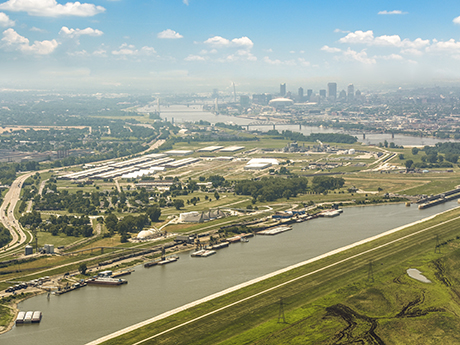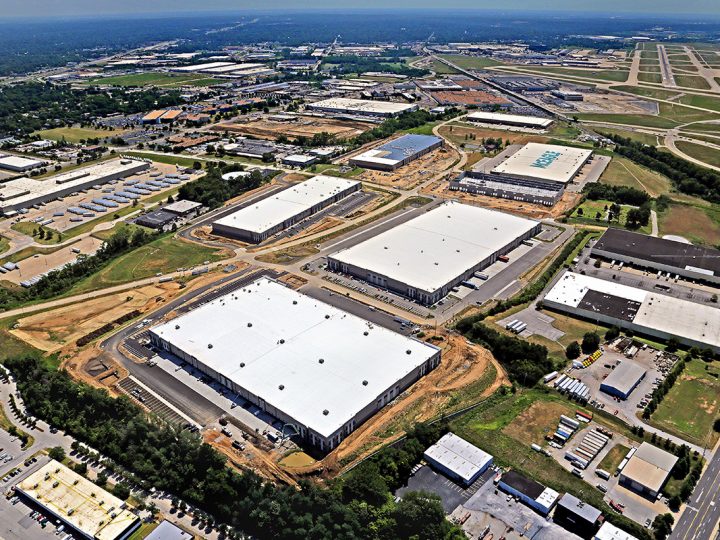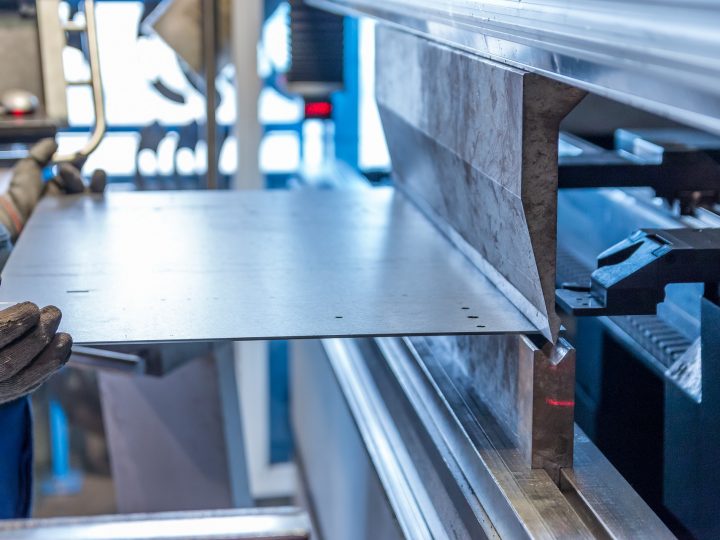
This article originally ran in the September 2020 issue of Heartland Real Estate Business magazine. (Photo courtesy of America’s Central Port)
By: Mary Lamie, Bi-State Development
The key to current and future success for four ports in Missouri and Illinois is collaboration. As ports continue to play a critical role in the global supply chain, the special working relationship between the directors of the ports in St. Louis and Kansas City is helping to keep operations flowing on the inland waterways, even in the midst of the COVID-19 pandemic. Significant investments in each port are also fueling growth at each facility.
“Like many others in the freight industry, we are classified as essential. We have access to six Class I railroads, two multimodal harbors, four interstate highways and millions of square feet of warehouse space, plus manufacturing areas and developable sites,” says Dennis Wilmsmeyer, executive director of America’s Central Port (ACP), where the constant level of activity reinforces the significance of all ports as the COVID-19 pandemic continues.
 With its location just north of St. Louis on the Illinois bank of the Mississippi River and its many transportation and logistical advantages, ACP has attracted 80-plus commercial tenants. Its harbor operators transport more than 3 million tons of goods valued at more than $1.1 billion annually.
With its location just north of St. Louis on the Illinois bank of the Mississippi River and its many transportation and logistical advantages, ACP has attracted 80-plus commercial tenants. Its harbor operators transport more than 3 million tons of goods valued at more than $1.1 billion annually.
Though the pandemic has resulted in necessary changes to protect workers and help prevent the spread of the coronavirus, and demand has shifted from some products to others, volumes have remained steady. That is evidence of the surprisingly minimal impact of COVID-19 on port operations to date. It is also a testament to the flexibility and adaptability of ACP.
This desire to adapt is also evident at the Kaskaskia Regional Port District (KRPD) in southwestern Illinois, which actually includes five terminals at five different locations and has grown to be the 10th-largest inland port in the nation.
As a port that had predominantly moved coal, KRPD saw that commodity drop from a high of 4 million tons annually to just 400,000, and realized the need to form relationships with new customers, diversify the product line and invest in infrastructure to succeed. That started with a 50-ton overhead crane at KRPD #2 that built some added capacity and attracted a steel processor, followed by a fertilizer company.
Additional improvements continue to be made by KRPD to address the need to move fly ash and gypsum outbound from the plant to markets around the country, and plans are in the works for a second rail loop, moving some outbound conveyers and some sidings.
Kaskaskia Regional Port District General Manager Ed Weilbacher hopes to get the $9 million project funded through a state capital program in partnership with the Economic Development Agency. A new entrance for KRPD #2 was recently completed and there is a new master plan for the port that will lead to further investments at that location and open it up for additional public-private development.
Port KC
Port KC also is growing. When the Kansas City Port Authority rebranded itself as Port KC in 2015, it was seeing approximately 300,000 tons of cargo other than sand and gravel move on the Missouri River, and by 2019 that had doubled to more than 600,000 tons of cargo moved along with 3.1 million tons of sand and gravel. Recent investments of $750,000 for new moorings and $1.7 million for a new storage facility should lead to additional growth.
But perhaps the most exciting development at Port KC is its 2018 acquisition of a shuttered 415-acre steel mill east of Kansas City. The mill site is rail, river and road served and right off I-35, and is being redeveloped into a rail and water intermodal terminal to serve the Kansas City region.
“We hear from shippers all over the country that they want options and don’t want to be tied to one gateway,” says Richard Grenville, vice president of multimodal logistics for Port KC. “I think the inland waterway system with the expansion of the Panama Canal moving the line from East Coast to West Coast has really helped us develop this concept of container-on-vessel (COV) on the Mississippi and adjacent rivers, and it’s going to be huge for the industry.”
Collaboration will be key to advancing the COV service, which would pair with container-on-barge service as part of a hub and spoke system that would include the various other ports in the St. Louis region, as well as the Port of Memphis. The Port of Herculaneum in Jefferson County, Missouri, has been identified as a hub for a key terminal in the proposed COV service.
Other key partners in the initiative include American Patriot Holdings (APH) and the Port of Plaquemines in southern Louisiana. The shared goal is to use patented vessels that APH is developing that would be capable of carrying mass quantities of containerized freight at more rapid upriver speeds on an all-water route.
The inland waterway route would connect ports in the St. Louis region and elsewhere in the Midwest to a gateway port at the Port of Plaquemines on the lower Mississippi River — and ultimately to Asia, Europe and other foreign ports. Two independent, third-party studies reveal shippers using the new service could see cost savings ranging from 40 to 44 percent.
“We’re in this together,” says Neal Breitweiser, executive director of the Jefferson County Port Authority. “We’re not competing as we all have the same goal of making an efficient waterway system that’s unlike any other in the world.”
While each port is clearly unique, the willingness to collaborate sends a clear message to the industry that the cooperation needed to develop an integrated transportation system already exists. Industry is appreciative of that collaboration and the role it plays in supporting affordable transport rates as a whole for the inland waterways.
Mary Lamie is executive vice president of multi-modal enterprises with Bi-State Development.




